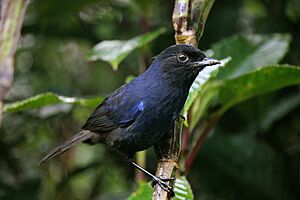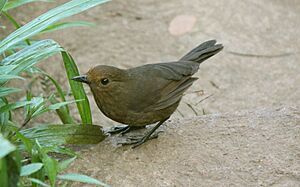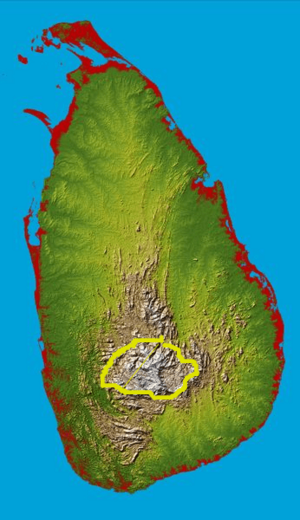Sri Lanka whistling thrush facts for kids
Quick facts for kids Sri Lanka whistling thrush |
|
|---|---|
 |
|
 |
|
| Male and female | |
| Conservation status | |
| Scientific classification | |
| Genus: |
Myophonus
|
| Species: |
blighi
|
 |
|
| yellow — boundary of range in the highlands | |
The Sri Lanka whistling thrush (Myophonus blighi) is a special type of whistling thrush. It belongs to the bird family called Muscicapidae. This bird lives only in Sri Lanka, which means it is endemic to that country.
Contents
About the Sri Lanka Whistling Thrush
The Sri Lanka whistling thrush is a small bird. It grows to about 20 centimeters (about 8 inches) long. This makes it one of the smaller whistling thrushes.
What They Look Like
Male and female Sri Lanka whistling thrushes look a bit different.
Male Birds
Adult male birds are mostly dark blue. Their head and back are even darker. They have bright blue patches on their shoulders. You can also see bright blue above their eyes and on their forehead.
Female Birds
Female birds are brown on their upper body. Their belly is a chestnut color. Like the males, females also have a bright blue patch on their shoulders.
Where They Live and What They Eat
These birds live in the highlands of Sri Lanka. They prefer jungles or thick forests. You will often find them near water sources.
Their Diet
The Sri Lanka whistling thrush is an omnivore. This means it eats both plants and animals. They enjoy a variety of foods, including:
- Insects
- Frogs
- Earthworms
- Berries
Nesting and Reproduction
When it's time to lay eggs, the female builds a neat nest. It is shaped like a cup. She places her nest in a bush or on a ledge. These nests are always close to water. The female usually lays one or two eggs.
Bird Behavior
These birds do not fly in large groups or flocks. Sometimes, a few birds might be found in the same area. This happens if the habitat is good for them.
Their Song
The male Sri Lanka whistling thrush sings a simple whistling song. They usually sing from inside trees. They like to stay hidden while singing.
Finding This Bird
The Sri Lanka whistling thrush is known for being very shy. It is also quite rare and lives in specific areas. This makes it hard to spot, even when males are singing. The breeding season starts in February.
You might have the best chance to see one at dawn. Good places to look include:
- Horton Plains National Park (about 2000 meters up in the highlands)
- Near the Haggala Botanical Gardens (close to Nuwara Eliya town)
The number of these birds is going down. This is mainly because their habitat is being lost.
In Culture
In Sri Lanka, people call this bird Lanka Arangaya. This is its name in the Sinhala language. The Sri Lanka whistling thrush has even appeared on a 75-cent Sri Lankan postal stamp.
Images for kids



